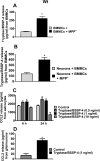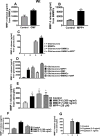Cross-Talk between Glia, Neurons and Mast Cells in Neuroinflammation Associated with Parkinson's Disease
- PMID: 28952015
- PMCID: PMC5802395
- DOI: 10.1007/s11481-017-9766-1
Cross-Talk between Glia, Neurons and Mast Cells in Neuroinflammation Associated with Parkinson's Disease
Abstract
Parkinson's disease (PD) is a progressive movement disorder characterized by neuroinflammation and dopaminergic neurodegeneration in the brain. 1-methyl-4-phenylpyridinium (MPP+), a metabolite of the parkinsonian neurotoxin 1-methyl-4-phenyl-1,2,3,6-tetrahydropyridine (MPTP) induces the release of inflammatory mediators from glial cells and neurons. Glia maturation factor (GMF), a brain proinflammatory protein, MPP+, and mast cell-derived inflammatory mediators induce neurodegeneration which eventually leads to PD. However, the precise mechanisms underlying interaction between glial cells, neurons and mast cells in PD still remain elusive. In the present study, mouse bone marrow-derived mast cells (BMMCs) and mouse fetal brain-derived mixed glia/neurons, astrocytes and neurons were incubated with MPP+, GMF and mast cell-derived inflammatory mediators mouse mast cell protease-6 (MMCP-6), MMCP-7 or tryptase/brain-specific serine protease-4 (tryptase/BSSP-4). Inflammatory mediators released from these cells in the culture medium were quantitated by enzyme-linked immunosorbent assay. Neurodegeneration was quantified by measuring total neurite outgrowth following microtubule-associated protein-2 immunocytochemistry. MPP+-induced significant neurodegeneration with reduced total neurite outgrowth. MPP+induced the release of tryptase/BSSP-4 from the mouse mast cells, and tryptase/BSSP-4 induced chemokine (C-C motif) ligand 2 (CCL2) release from astrocytes and glia/neurons. Overall our results suggest that MPP+, GMF, MMCP-6 or MMCP-7 stimulate glia/neurons, astrocytes or neurons to release CCL2 and matrix metalloproteinase-3. Additionally, CD40L expression is increased in BMMCs after incubation with MPP+ in a co-culture system consisting of BMMCs and glia/neurons. We propose that mast cell interaction with glial cells and neurons during neuroinflammation can be explored as a new therapeutic target for PD.
Keywords: 1-methyl-4-phenylpyridinium; CCL2; Cytokines; Glia maturation factor; Mast cells; Microtubule-associated protein-2; Neuroinflammation; Parkinson’s disease.
Conflict of interest statement
Authors declare that they have no competing interests.
Figures








Similar articles
-
Mast Cell Proteases Activate Astrocytes and Glia-Neurons and Release Interleukin-33 by Activating p38 and ERK1/2 MAPKs and NF-κB.Mol Neurobiol. 2019 Mar;56(3):1681-1693. doi: 10.1007/s12035-018-1177-7. Epub 2018 Jun 18. Mol Neurobiol. 2019. PMID: 29916143 Free PMC article.
-
Mast Cells Release Chemokine CCL2 in Response to Parkinsonian Toxin 1-Methyl-4-Phenyl-Pyridinium (MPP(+)).Neurochem Res. 2016 May;41(5):1042-9. doi: 10.1007/s11064-015-1790-z. Epub 2015 Dec 8. Neurochem Res. 2016. PMID: 26646004 Free PMC article.
-
Glia Maturation Factor and Mast Cell-Dependent Expression of Inflammatory Mediators and Proteinase Activated Receptor-2 in Neuroinflammation.J Alzheimers Dis. 2018;66(3):1117-1129. doi: 10.3233/JAD-180786. J Alzheimers Dis. 2018. PMID: 30372685 Free PMC article.
-
Brain and Peripheral Atypical Inflammatory Mediators Potentiate Neuroinflammation and Neurodegeneration.Front Cell Neurosci. 2017 Jul 24;11:216. doi: 10.3389/fncel.2017.00216. eCollection 2017. Front Cell Neurosci. 2017. PMID: 28790893 Free PMC article. Review.
-
Estrogen, neuroinflammation and neuroprotection in Parkinson's disease: glia dictates resistance versus vulnerability to neurodegeneration.Neuroscience. 2006;138(3):869-78. doi: 10.1016/j.neuroscience.2005.07.060. Epub 2005 Dec 5. Neuroscience. 2006. PMID: 16337092 Review.
Cited by
-
Mast Cell Activation in Brain Injury, Stress, and Post-traumatic Stress Disorder and Alzheimer's Disease Pathogenesis.Front Neurosci. 2017 Dec 12;11:703. doi: 10.3389/fnins.2017.00703. eCollection 2017. Front Neurosci. 2017. PMID: 29302258 Free PMC article. Review.
-
Modulation of Peripheral Mast Cell and Brain Microglia Axis via Kinase Inhibition.Metabolites. 2025 Mar 11;15(3):194. doi: 10.3390/metabo15030194. Metabolites. 2025. PMID: 40137158 Free PMC article.
-
Role and mechanisms of mast cells in brain disorders.Front Immunol. 2024 Aug 26;15:1445867. doi: 10.3389/fimmu.2024.1445867. eCollection 2024. Front Immunol. 2024. PMID: 39253085 Free PMC article. Review.
-
The Interplay Between Epilepsy and Parkinson's Disease: Gene Expression Profiling and Functional Analysis.Mol Biotechnol. 2025 Mar;67(3):1035-1053. doi: 10.1007/s12033-024-01103-y. Epub 2024 Mar 7. Mol Biotechnol. 2025. PMID: 38453824
-
Mast Cells in Neurodegenerative Disease.Front Cell Neurosci. 2019 Apr 30;13:171. doi: 10.3389/fncel.2019.00171. eCollection 2019. Front Cell Neurosci. 2019. PMID: 31133804 Free PMC article.
References
-
- Bennett JL, Blanchet MR, Zhao L, Zbytnuik L, Antignano F, Gold M, Kubes P, McNagny KM. Bone marrow-derived mast cells accumulate in the central nervous system during inflammation but are dispensable for experimental autoimmune encephalomyelitis pathogenesis. J Immunol. 2009;182:5507–5514. - PubMed
-
- Cottrell GS, Amadesi S, Schmidlin F, Bunnett N. Protease-activated receptor 2: activation, signalling and function. Biochem Soc Trans. 2003;31:1191–1197. - PubMed
Publication types
MeSH terms
Grants and funding
LinkOut - more resources
Full Text Sources
Other Literature Sources
Medical

